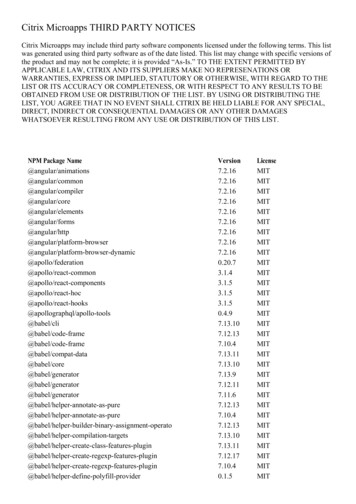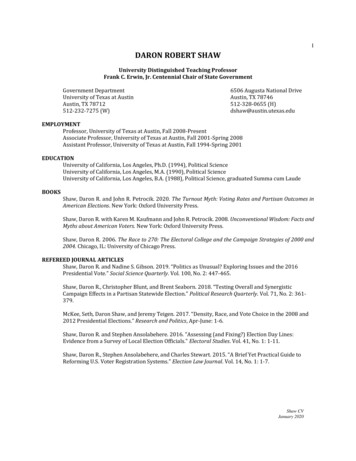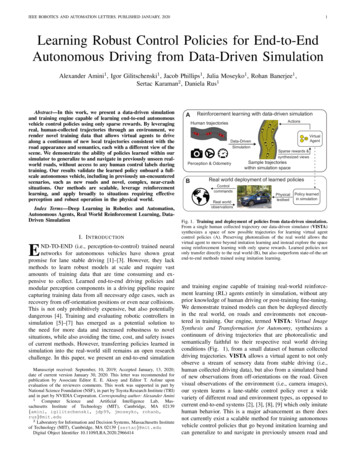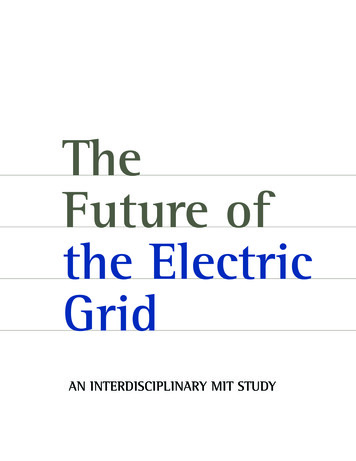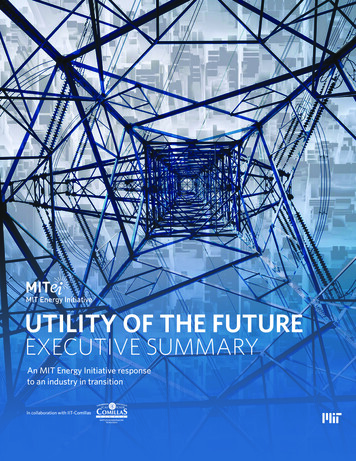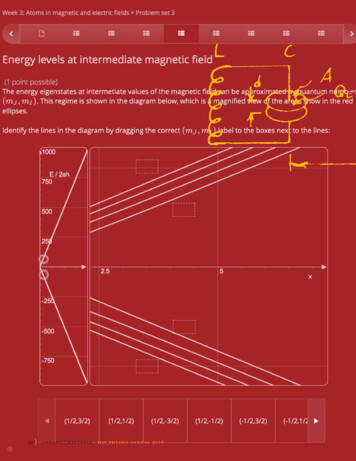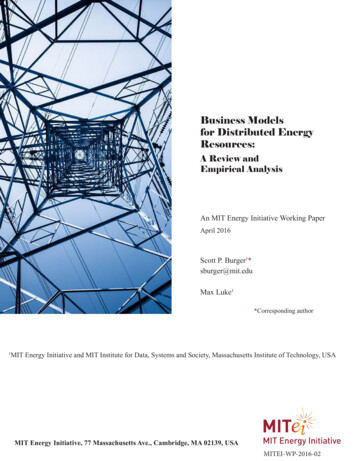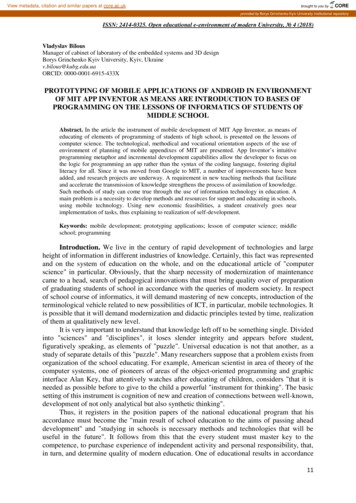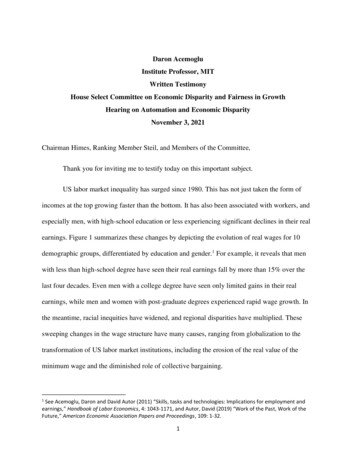
Transcription
Daron AcemogluInstitute Professor, MITWritten TestimonyHouse Select Committee on Economic Disparity and Fairness in GrowthHearing on Automation and Economic DisparityNovember 3, 2021Chairman Himes, Ranking Member Steil, and Members of the Committee,Thank you for inviting me to testify today on this important subject.US labor market inequality has surged since 1980. This has not just taken the form ofincomes at the top growing faster than the bottom. It has also been associated with workers, andespecially men, with high-school education or less experiencing significant declines in their realearnings. Figure 1 summarizes these changes by depicting the evolution of real wages for 10demographic groups, differentiated by education and gender.1 For example, it reveals that menwith less than high-school degree have seen their real earnings fall by more than 15% over thelast four decades. Even men with a college degree have seen only limited gains in their realearnings, while men and women with post-graduate degrees experienced rapid wage growth. Inthe meantime, racial inequities have widened, and regional disparities have multiplied. Thesesweeping changes in the wage structure have many causes, ranging from globalization to thetransformation of US labor market institutions, including the erosion of the real value of theminimum wage and the diminished role of collective bargaining.1See Acemoglu, Daron and David Autor (2011) “Skills, tasks and technologies: Implications for employment andearnings,” Handbook of Labor Economics, 4: 1043-1171, and Autor, David (2019) “Work of the Past, Work of theFuture,” American Economic Association Papers and Proceedings, 109: 1-32.1
Figure 1: Evolution of real wages by ten demographic groups, 1963-2017. From Autor (2019).My research, however, indicates that the most important factor in these trends has beenautomation — that is, the substitution of machines and algorithms for tasks previously performedby workers. Automation is not a recent phenomenon. The beginning of the British IndustrialRevolution was marked by rapid advances in automation technologies in the textile industry, andautomation played a major role in American industrialization during the 19th century. The rapidmechanization of agriculture starting in the middle of the 19th century is another example ofautomation. The more recent wave of automation has been dominated by numerically-controlledmachinery and then robotics in manufacturing and software-based automation in clerical andoffice jobs.2
Two types of evidence illustrate the effects of automation technologies on inequality.First, in local labor markets (commuting zones) where there has been faster adoption ofindustrial robots, we see not just lower employment and wages, but also greater inequalitybetween high-education and low-education workers and a bigger gap between those at the topand bottom of the income distribution.2 Second, and more directly, Figure 2 depicts therelationship between task displacement (the amount of automation) experienced by ademographic group and its real wage change between 1980 and 2016. These demographic groupsare distinguished by education, gender, age, race and native/immigrant status. Worker groupssuffering larger task displacement — the ones employed in routine tasks that can automated inindustries undergoing rapid automation — have almost uniformly experienced large declines intheir real wages.3 These groups include all demographic categories with less than a collegedegree. In contrast, groups that have not experienced much direct automation, including thosewith post-graduate degrees and women with college degrees, have seen their earnings increaserapidly over the last 40 years. In summary, Figure 2 indicates that more than half, and perhaps asmuch as three quarters, of the surge in wage inequality in the US is related to automation.Automation is not the only phenomenon that has led to task displacement. Workers mayalso lose the tasks they used to specialize in to offshoring and foreign competition. These trendshave also contributed to rising economic disparities, but comparatively, they have been lessimportant than automation. For example, the direct effects of offshoring account for about 5-7%of changes in wage structure, compared to 50-70% by automation.2Acemoglu, Daron and Pascual Restrepo (2020) “Robots and Jobs: Evidence from US Labor Markets,” Journal ofPolitical Economy, 128(6): 2188-22443Acemoglu, Daron and Pascual Restrepo (2021) “Automation, Tasks and the Rise in US Wage Inequality” NBERWorking Paper No. 28290.3
Figure 2: Task displacement (the amount of automation) experienced by a demographic group andchange in that demographic group’s real wage from 1980 to 2016. Demographic groups are defined byeducation, age, gender, race and native/immigrant status. From Acemoglu and Restrepo (2021).While the main impact of automation over the last four decades has been on wages,workers most affected by automation have also seen their labor force participation andemployment rates decline. The evidence does not support the most alarmist views that robots orAI are going to create a completely jobless future, but we should be worried about the ability ofthe US economy to create jobs, especially good jobs with high pay and career-buildingopportunities for workers with a high-school degree or less.Automation has contributed to specific dimensions of economic disparities as well.Automation accounts for 80% of the sizable increase in the college wage premium (the earningsof college-educated workers relative to those with just a high-school degree). It has also widenedthe gap between Black and White Americans. Without automation, we estimate that the racialwage gap (after taking out differences in education, age and gender) would have closed by 2percentage points between 1980 and 2017, but because of automation, it has widened by 3.54
percentage points. Automation, together with globalization, has also been a major driver ofregional disparities. Some of the industries most affected by both globalization and industrialrobotics were heavily concentrated in specific areas, such as Detroit or Raleigh Durham, and asthey reduced their hiring, these local economies have been pushed into decline and stagnation.4One dimension of disparities that has been helped by automation is the gender wage gap.Although several occupations in which women are overrepresented have also been automated, onthe whole it has been male-dominated occupations that have undergone faster automation. As aresult, automation has helped close the gender wage gap and is responsible for about 17% of thenarrowing of this gap since 1980.5But what about the benefits of automation? During the mechanization of agriculture or inthe three decades following World War II, automation was also rapid, and the US economycreated millions of jobs and achieved broadly-shared prosperity, which can also be seen fromFigure 1 above — real wages for all ten demographic groups depicted there grew in tandem, at arate exceeding 2% per annum in real terms, on average. So what is different today?Two major factors should be emphasized. First, automation technologies in the first halfof the 20th century and in the 1950s and 1960s went hand-in-hand with other technologicaladvances, which increased worker productivity in a diverse set of industries and created myriadopportunities for them. Chief among those advances is the introduction of new labor-intensivetasks, such as clerical tasks both in manufacturing and non-manufacturing, technical occupations,4On the effects of imports from China, see Autor, David, David Dorn, and Gordon Hanson (2013) “The ChinaSyndrome: Local Labor Market Effects of Import Competition in the United States” American Economic Review103(6): 2121-68. On the effects of industrial robots, see Acemoglu, Daron and Pascual Restrepo (2020) “Robotsand Jobs: Evidence from US Labor Markets,” Journal of Political Economy, 128(6): 2188-2244.5Acemoglu, Daron and Pascual Restrepo (2021) “Automation, Tasks and the Rise in US Wage Inequality,” NBERWorking Paper No. 28290.5
design tasks and precision work in manufacturing. What we have experienced since the mid1980s is an acceleration in automation and a very sharp deceleration in the introduction of newtasks. Put simply, the technological portfolio of the American economy has become much lessbalanced, and in a way that is highly detrimental to workers and especially low-educationworkers.6Second, not all automation technologies are created equal. Those that reduce costs andboost productivity generate a set of compensating changes, for example, expanding employmentin non-automated tasks. On the other hand, if automation is “so-so” — meaning that it generatesonly minor productivity improvements — then it creates all the displacement effects but little ofthe compensating benefits. As the US economy shifted more and more into automation, it mayhave also gone into less beneficial types of automation (compare, for instance, the benefits ofmechanization of agriculture to those of automated customer service).This discussion underscores another important problem. In some popular discussions,technology-based explanations for the rise in US wage inequality are pitted against those thatemphasize the decline of unions or the erosion of the real value of the minimum wage, with theimplication that the latter causes are more controllable. This is a false dichotomy in two ways.All those causes have contributed to the current situation, and technology is a factor that humanscan control. Technology is very much what we create with our collective knowledge, and thetechnological choices we make can have huge distributional consequences, and sometimes fewaggregate benefits.6Acemoglu, Daron and Pascual Restrepo (2019) “Automation and New Tasks: How Technology Changes LaborDemand,” Journal of Economic Perspectives, 33(2): 3-30.6
The technologies that are developed depends on society’s institutions, including thosethat govern how the labor market functions and who has social and political power. My readingof the evidence is that a number of factors have pushed US businesses towards automating theproduction process excessively, and as a result greatly contributed to inequality, but withoutgenerating significant aggregate benefits.7The first factor that has led to excessive automation is the transformation in the corporatestrategies of leading companies. American and world technology is shaped by the decisions of ahandful of very large and very successful tech companies, with tiny workforces and a businessmodel built on automation.8 Big tech companies have had a defining impact on the direction ofdigital technologies in general, and are today dominating the path of artificial intelligence (AI).Available data suggest that US and Chinese tech giants are responsible for more than two out ofevery three dollars spent globally on AI.9 There is of course nothing wrong with successfulcompanies pursuing technological advances consistent with their business model. The problem isthat these companies have become so dominant both in their sector and in terms of their impacton US society’s priorities that their approach has become the only game in town. Pasttechnological successes have more often than not been fueled by a diversity of perspectives andapproaches, and if we lose that diversity, it can have disastrous consequences, including oneconomic disparities.The dominance of the paradigm of a handful of companies has been exacerbated bydeclining government support for fundamental research, as government spending on research has7Acemoglu, Daron (2021) Redesigning AI: Work, Democracy, and Justice in the Age of Automation, Boston ReviewForum.8Acemoglu, Daron, and Pascual Restrepo (2020) “The Wrong Kind Of AI? Artificial Intelligence and The Future OfLabour Demand.” Cambridge Journal of Regions, Economy and Society 13.1: 25-35.9Artificial Intelligence: The Next Digital Frontier? McKinsey & Company.7
fallen as a fraction of GDP and its composition has shifted towards tax credits and support forcorporations. 10 The transformative technologies of the 20th century, such as antibiotics, sensors,modern engines, and the Internet, have the fingerprints of the government all over them.11 Thegovernment funded and purchased these technologies and often set the research agenda. This ismuch less true today.US businesses have also invested heavily in automation in response to globalizationtrends. First with the rapid increase in imports from Japan in the 1980s and then the surge ofimports from China, they became much more focused on cost-cutting, and automation providedone easy way of reducing labor costs.Finally, government policy is encouraging automation excessively, especially through thetax code. The US tax system has always treated capital more favorably than labor, encouragingfirms to substitute machines for workers, even when workers may be more productive. As Figure3 shows, over the last 40 years, via payroll and federal income taxes, labor pays an effective taxrate of over 25%. Even twenty years ago, capital was taxed more lightly, with equipment andsoftware facing tax rates around 15%. This differential has widened even more with tax cuts onhigh incomes, the shift of many businesses to S-Corporation status making them exempt fromcorporate income taxes, and very generous depreciation allowances. As a result of these changes,software and equipment are taxed close to zero now and in some cases, corporations can get a netsubsidy when they invest in capital. This generates a powerful motive for excessive automation:Companies can save money when they install machinery to do the same jobs as workers and lay10Gruber, Johnson, and Simon Johnson. Jump-Starting America: How Breakthrough Science Can Revive EconomicGrowth and the American Dream. Public Affairs, New York, NY, 2019.11Lerner, Josh. Boulevard of Broken Dreams: Why Public Efforts to Boost Entrepreneurship and Venture CapitalHave Failed and What to Do about It. Princeton University Press, New York, 2009, and Mazzucato, Mariana. TheEntrepreneurial State: Debunking Public Versus Private Sector Myths. Public Affairs, New York, 2015.8
off their employees, because the government subsidizes their investments and taxes what theypay in wages.Figure 3: Evolution of effective taxes in the U.S. From Acemoglu, Daron, Andrea Manera and Pascual Restrepo(2020) “Does the US Tax Code Favor Automation,” Brookings Papers on Economic Activity.If economic disparities in the US have been at least partly fueled by technologicalchoices, then it should be clear that redirecting our technological energy and ingenuity must playa leading role in redressing these disparities.Popular accounts and tech entrepreneurs often imply that the future of technology islargely preordained or, alternately, the most promising directions are being explored already.This is not necessarily the case. There are many different feasible paths for future technology,9
and we are not choosing the ones that are best for social good, as current choices in the industryare excessively automating work. There are many applications of AI that instead augment humancapabilities and create new tasks in education, health care, and even in manufacturing. Forexample, rather than using AI for automated grading, homework help, and increasingly forsubstitution of algorithms for teachers, the industry can invest in using AI for developing moreindividualized, student-centric teaching methods that are calibrated to the specific strengths andweaknesses of different groups of pupils. Such technologies would lead to the employment ofmore teachers, as well as increasing the demand for new teacher skills — thus exactly going inthe direction of creating new jobs centered on new tasks. Similar possibilities abound in healthcare, for example, in improving care quality by empowering nurses. The problem, however, isthat without a push for redirection of technological change, the tech industry is currently muchmore focused on using AI and digital technologies for automation, rather than producingopportunities for workers.Some policymakers might be tempted to tackle economic disparities directly, forexample, by increasing the minimum wage. The evidence supports the view that moderateincreases in minimum wages can help low-pay workers without generating large adverseconsequences on employment. However, the minimum wage and other direct interventions in thelabor market by themselves cannot be the main solution to rising inequality, especially whenautomation is playing such an important role. If the minimum wage is raised significantly, thiswill be another trigger for companies to automate work. Indeed, the pandemic has demonstratedhow modest wage pressure and labor shortages have led to much faster automation in consumerfacing industries, such as fast food and groceries.10
What can be done to redirect technological change in a more worker-friendly direction?A first and easy step is to correct the differential taxation of capital and labor. This would go along way but is not sufficient by itself. This need not take the form of punitive taxes on capital.A large part of the gap between the taxation of capital and labor comes from very generousdepreciation allowances that started being introduced in 2000, and were supposed to betemporary. They can be eliminated, as they were meant to be temporary. In addition, US taxrevenues are unduly hurt because the base for capital taxes is very narrow, as many businessesdo not pay any corporate income taxes. Closing tax evasion loopholes and applying corporateincome taxes to previously exempt businesses, such as S-corporations, would go a long way aswell. Finally, corporate income taxes can be increased in coordination with other advancedeconomies. Recent policy proposals on the global minimum corporate tax go some way towardsredressing these problems, but much more effort is necessary to broaden the capital tax base andto create a level playing field between capital and labor.A second and more ambitious step should be to reevaluate the role of large techcompanies. Big Tech has a particular approach to business and technology, centered on the useof algorithms for replacing humans. It is no coincidence that companies such as Google areemploying less than one tenth of the number of workers that large businesses, such as GeneralMotors, used to do in the past. This is a consequence of Big Tech’s business model, which isbased not on creating jobs but automating them. There is increasing recognition that these largecompanies are having huge effects on our society that need to be regulated (for example, when itcomes to Facebook’s role in polarization and the spread of misinformation). Their effects ontechnology, and especially on economic opportunities for low-skill Americans, may be evenmore consequential, and have not become a policy focus so far. This should change, and11
policymakers should think about ways in which the considerable technological know-how andcapabilities of our economy can be used for creating opportunities for Americans of allbackgrounds and skills. These issues go beyond debates about automation, as they relate to theissue of limiting the size and the dominance of big tech companies, and are also entangled withquestions of market power and anti-trust. Nevertheless, existing policy proposals, including antitrust, are no direct remedy for encouraging a more diverse approach to new technologies. Suchan approach would require greater social diversity among executives and researchers, includingamong large tech firms, and ways of lessening the dominance of Big Tech so that newcompanies can enter and build technologies that generate new tasks and opportunities for bothlow-education and high-education Americans.Measures aimed at removing the distortions that encourage excessive automation can bestrengthened with government R&D policies specifically targeting technologies that help humanproductivity and increase labor demand. Research policies that target specific classes oftechnologies are controversial and difficult. They may be particularly challenging in the contextof choosing between automation and human-friendly technologies, since identifying these maybe nontrivial. Nevertheless, I would like to end my comments by emphasizing that there havebeen successful instances of technological redirection in the past.Two decades ago renewable energy was prohibitively expensive and the basic know-howfor large-scale energy production from green technologies was lacking. Today renewablesalready make up 19% of energy consumption in Europe and 11% in the US, and have costs in thesame ballpark as fossil-fuel based energy.12 This has been achieved thanks to a redirection of12Renewable Power Generation Costs in 2018, International Renewable Energy Agency; Global renewable energyconsumption, Our World in Data. See also https://www.lazard.com/perspective/lcoe2019/;12
technological change away from a singular focus on fossil fuels towards greater efforts foradvances in renewables. In the US, the primary driver of this redirection has been governmentsubsidies to green technologies and state-level regulations, as well as the changing norms ofconsumers in society, which have pushed many companies towards reducing their emissions.The experience in the energy sector shows that it is feasible to redirect technologicalchange. The same can be done for the balance between automation and human-friendlytechnologies, but as in the case of combating global warming, change must start with a broaderrecognition within society and among policymakers that our technology choices have becomehighly unbalanced, with myriad adverse social consequences, including on economic 492?via%3Dihub13
House Select Committee on Economic Disparity and Fairness in Growth Hearing on Automation and Economic Disparity November 3, 2021 Chairman Himes, Ranking Member Steil, and Members of the Committee, Thank you for inviting me to testify today on this important subject. US labor market inequality has surged since 1980.
